I’ve been working with OpenStreetMap (OSM) data this week. The great thing about OSM (besides already containing a huge amount of road data) is that you can edit and correct data – that is, OSM manages the problem of “crowd sourcing” world map source data.
I get email from people all the time, saying “how can I help fix my local area of the global scenery”. With OSM, you can help., by improving OSM’s source data.
Here are two things that will matter in the quality of generated scenery:
- The oneway tag. Roads that are one-way need to have this tag, or the conversion to X-Plane might have an incorrect two-way road in place. If you don’t see the one-way arrows on the OSM map rendering then this tag might be missing.
- The layer tag. When roads cross, “layer” tells OSM which one is on top (and that they do not intersect). Similarly, if a highway is underground, it’s because it has a negative layer. If the layer tag is missing, complex intersections will probably render as junk.
In the US, a lot of OSM is built off an import of the TIGER census road map. Unfortunately TIGER in its previous released form does not contain one-way or layering information. So particularly for US cities, adding these tags will improve the road rendering a lot!
There is a bug in the newly released 931. When:
- Clouds are set to stratus and
- Pixel shaders are on and
- The airplane has an OBJ that uses ATTR_diffuse_rgb
the attribute is ignored, which typically makes things appear white. The primary example that has been reported to me is the throttle quadrant of the Piper Malibu.
This is simply a bug in the shaders (which is failing to apply the diffuse tinting to ambient-only lighting conditions); I have a fix, but I’m not sure how soon it will be released. We will probably do a small bug-fix release with this and one or two other things, but this is yet to be finalized, since Austin is out of the office this week.
I receive bug reports periodically relating to how X-Plane and the scenery tools handle badly formed scenery files. Here’s the rules:
- It is a bug in the scenery tools if they create illegal scenery data. They should at least flag the condition that is leading to an illegal file and refuse to proceed.
- It is a bug in the scenery tools if they crash when trying to import illegal scenery data. Crashing can mean data loss, which is bad.
- X-Plane’s behavior with regards to illegal scenery data is undefined! This means it is not a bug for X-Plane to show a certain behavior with bad input data.
- There is no guarantee that X-Plane’s response to illegal scenery data will remain constant over multiple patches, or even multiple executions of the sim.
This third point has some dangerous consequences:
- X-Plane might handle illegal data in a way that an author views as useful; this “useful” side effect might go away in a future version.
- X-Plane might crash in response to illegal data…sometimes.
- There is no guarantee that X-Plane will provide useful diagnostics.
The reason for this scheme is that X-Plane is under pressure to get scenery loaded quickly, so at some point, there is a limit to how much validation it can do.
With that in mind, I do try to validate scenery when a problem is very common and the validation is not very expensive, or when there are serious data quality problems. But as we move to having the tools do more validation, we can have validation where we need it: immediately, for the authors working on the scenery.
To answer the most basic questions:
- This is a base mesh orthophoto scenery I made with MeshTool, as a test.
- The source DEM is 10m NED, the source imagery is 1mpp DOQQ, down-scaled to 3mpp. I gave MeshTool a point budget of 500,000 mesh points per DSF tile, and it used them all.
- This version of MeshTool (2.0 beta 2) should be out in the next 3 days.
- That’s X-Plane 930RC4. The framerate really is around 100 fps.
- There are no dynamic real-time shadows. Rather, the orthophotos have the shadows “baked” in because they’re photos.
- There are artifacts at the joins of the orthophotos because I spent time fixing projection errors.
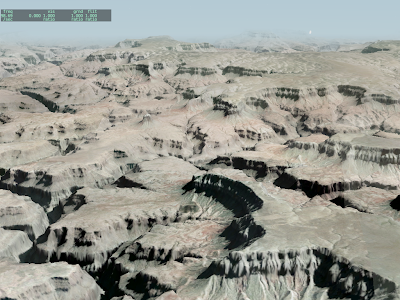
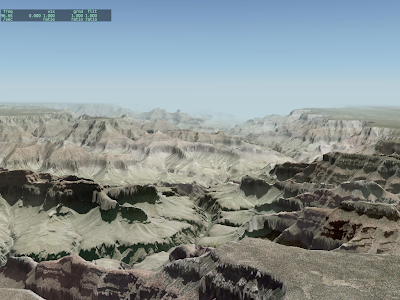
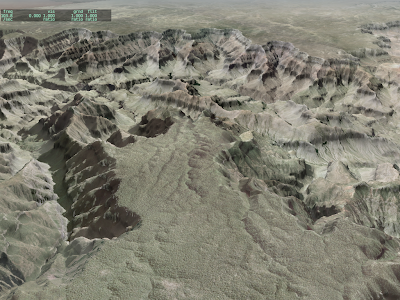
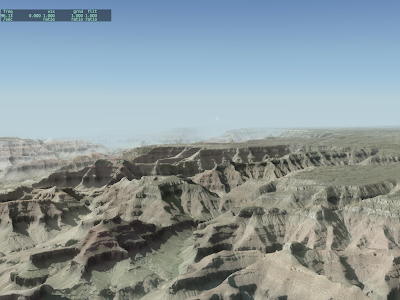
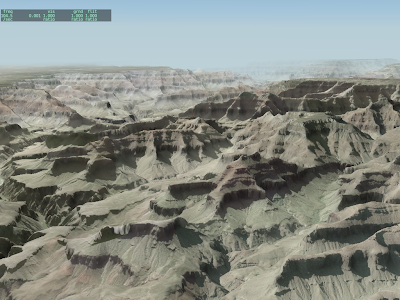
Clearly we need more than 25 nm visibility in some cases!
I have received several requests for a transparent runway with a physical surface type. That request is just strange enough that we need to look back and ask, “how did we get here?”
High Level and Low Level Modeling
The “new” airport system, implemented in X-Plane 850 (with a new apt.dat spec to go with it) is based on a set of lower level drawing primitives, all of which are available via DSF. In other words, if Sergio and I can create an effect to implement the apt.dat spec, you can make this effect directly with your own art assets using a DSF overlay. This relieves pressure on the apt.dat spec to become a kitchen sink of tiny details.
The goal of apt.dat is to make a visually pleasing general rendering of airport data. DSF overlays provide a modeling facility.
Little Tricks
It turns out there are two things the apt.dat file “does” with the rendering engine that you can’t do in an overlay DSF:
-
The apt.dat file registers runways in the airport dialog box (for starting flights, positioning the airplane, etc.).
-
When the apt.dat reader places OBJs to form approach lights, it can offset their “timing base”, which is why the rabbit flashes in sequence.
(If you were to place a sequence of approach lights with rabbits in an overlay, every single light would flash at the same time because the DSF overlay format does not have a way to adjust the object’s internal timing parameter.)
The solution: the transparent runway. The idea of the transparent runway is to create with the apt.dat file the two aspects of a runway that you can’t build with a DSF overlay: the approach lights and the entry in the global airport dialog box. Transparent runways leave the drawing and surface up to you.
My thinking at the time was that the actual runway visuals and physics would be implemented together via either draped polygons or a hard OBJ.
Orthophotos and Bumps
So why do authors want a transparent but hard runway? The answer is orthophotos. With paged orthophotos, it is now possible to simply put down orthophotos for the entire airport surface area (whether as overlays or a base mesh) at some high resolution (our runways are 10 cm per pixel – I’m not sure if the whole airport area can be done at that resolution) and not have any special overlays for the runways. The transparent + hard runway would change the surface type.
I’m not sure if this is a good idea, but I’m pretty sure that this feature belongs in overlay DSFs and not the apt.dat file.
- Such a technique (varying hard surfaces independent of a larger image) is useful for more than just airports (and certainly more than just runways).
- The technique is unnecessary unless a DSF overlay is in use.
- Unlike nearly all of the rest of the apt.dat file, such an abstraction (invisible but bumpy) is much more a modeling technique and less a description of a real world runway.
I’m not sure we would even want the runway outline to be the source of hard data. If there are significant paved areas outside the runway then a few larger hard surface polygons might be more useful.
The dataref documentation on the X-Plane SDK website is updated for each release of X-Plane 9.
X-Plane 930 has not yet been released. It is a “release candidate” but since we haven’t signed off on it yet, 922r1 is still the most current real release of X-Plane, and it’s what users get when they update without asking for a beta. So the website has 922 datarefs.
Since version 9, every release of X-Plane (including betas and RCs) has a copy of datarefs.txt in the plugins folder that is correct for that release. In other words, the docs that ship with X-Plane and the sim itself are always in sync.
So for now use datarefs.txt in the 930 RC 2 plugins folder! When 930 goes final, the website will be updated.
A few days ago, the ASTER GDEM was released. Basically ASTER GDEM is a new elevation set with even greater coverage than the SRTM. Basically both SRTM and ASTER (I’ll drop the GDEM – in fact ASTER prodcues more than just elevation data, but the elevation data is what gets flight simmers excited right now) are space-based automated measurement of the earth’s height. But since ASTER is on a satellite (as opposed to an orbiting space shuttle) it can reach latitudes closer to the poles.
So what does this mean for scenery? What does it mean for the global scenery? A few thoughts:
-
ASTER data is not yet very easy to get. You can sign up with the USGS distribution website but you’re limited to 100 tiles at a time, with some latency between when you ask and when you get an FTP site. Compare this to SRTM, which can be downloaded automatically in its entirety, or ordered on DVD. ASTER may reach this level of availability, but it’s not there yet.
-
ASTER is, well, lumpy. (Nasa says “research grade”, but you and I can say “lumpy”.) Jonathan de Ferranti describes ASTER and its limitations in quite some detail. Of particular note is that while the file resolution is 30m, the effective resolution of useful data will be less.
SRTM has its defects, too, but ASTER is very new, so the GIS community hasn’t had a chance to produce “cleaned up” ASTER. And clean-up matters; it only takes one really nice big spike in a flat flood plane to make a “bug” in global scenery. I grabbed the ASTER DEMs for the Grand Canyon. Coverage was quite good, despite the steep terrain angle (steep terrain is problematic by design for SRTM) but there were still drop-out areas that were filled with SRTM3 DEMs, and the filled-in area was noticeable.
-
By the numbers, ASTER is not as good as NED; I imagine that other country-specific national elevation datasets are also both more accurate and more precise than ASTER.
-
The licensing terms are, well, unclear. The agreements I’ve seen imply a limited set of research uses for the data. The copyright terms are not well specified.
So at this point I think ASTER is a great new resource for custom scenery, where an author can grab an ASTER DEM in a reasonable amount of time, check it carefully, and thus have access to high quality data for remote parts of the Earth, particularly areas where locally grown data is not available or not high quality.
In the long term, ASTER is a huge addition to the set of data available because of its wide-scale coverage of remote areas, and because it can fill holes in SRTM. (ASTER and SRTM suffer from different causes for drop-outs, so it is imaginable that there won’t be a 1:1 correlation in drop-outs.)
But in the short term, I don’t think ASTER is a SRTM replacement for global scenery; void-filled SRTM is a mature product, reasonably free of weirdness (and sometimes useful data). ASTER is very new, and exciting, but not ready for use in global scenery.
FSBreak interviewed Austin last week….it’s an interesting listen and they cover a lot of ground. A few comments on Laminar’s approach to developing software:
That Code Stinks!
Austin is absolutely correct that we (LR) write better software because neither of us are shy about telling the other when a piece of code stinks. But I think Austin deserves the credit for creating this environment. An “ego-free” zone where people can criticize each other honestly and freely is a rare and valuable thing, in many domains, not just music.
When I first came to LR, Austin created this environment by responding positively to feedback, no matter how, um, honest. When I first came to LR 100% of the code was written by him and 0% by me. Thus if I was going to say “this piece of code really needs to be different”, it was going to be Austin to either run with it or try to defend his previous work.
To his credit, Austin ran with it, 100% of the time. I can’t think of a single time that he didn’t come down on the side of “let’s make X-Plane better”. That set the tone for the environment we have now: one that is data driven, regardless of who the original author is.
I would say this to any programmer who faces a harsh critique of code: good programmers write bad code! I have rewritten the culling code (the code that decides whether an OBJ really needs to be drawn*) perhaps four times now in the last five years. Each time I rewrote the code, it was a big improvement. But that doesn’t make the original code a mistake – the previous iterations were still improvements in their day. Programming is an iterative process. It is possible to write code that is both good and valuable to the company and going to need to be torn out a year later.
A Rewrite Is Not A Compatibility Break
Austin also points to the constant rewriting of X-Plane as a source of performance. This is true too – Austin has a zero tolerance policy toward old crufty code. If we know the code has gotten ugly and we know what we would do to make the code clean, we do that, immediately, without delay. Why would you ever put off fixing old code?
Having worked like this for a while, I am now amazed at the extent to which other organizations (including ones I have worked in) are willing to put off cleaning up code organization problems.
Simply put, software companies make money by changing code, and the cost is how long the changes take. If code is organized to make changing it slower, this fundamentally affects the financial viability of the company! (And the longer the code is left messy, the more difficult it will be to clean up later.)
But I must also point out one critical detail: rewriting the code doesn’t mean breaking compatibility! Consider the OBJ engine, which has been rewritten more times than I care to remember. It still loads OBJ2 files from X-Plane 620.
When we rework a section of the sim, we make sure that the structure of the code exactly matches what we are working on now (rather than what we were working on two years ago) so that new development fits into the existing code well. But it is not necessary to drop pieces of the code to achieve that. I would describe this “refactoring” as straightening a curvy highway so you can drive faster. If the highway went from LA to San Francisco, it still will – just in less time.
In fact, I think the issue of compatibility in X-Plane’s flight model has a lot more to do with whether the goal is to emulate reality or past results. This debate is orthoganal to refactoring code on a regular basis.
* Since OBJs are expensive to draw and there are a huge number of OBJs in a scenery tile, the decision about whether to draw an OBJ is really important to performance. Make bad decisions, you hurt fps. Spend too long debating what to draw, you also hurt fps!
For most of its beta run, X-Plane 930 beta 14 didn’t handle engine power limiting very well*. Here’s the short version of the saga.
- Real planes sometimes have systems to limit total power output, because the power output of the engine (whether torque or internal temperature) can exceed safe operating limits at sea level).
- With X-Plane 9.00 you could set a critical altitude for an airplane – below this altitude, X-Plane would limit the power output of the jet. The idea is (roughly) to simulate these limiters by derating the engine’s power output below this “critical altitude”.
- This feature was really only meant for reciprocating engines – when Austin discovered in 9.20 that people were using this for turbines (understandable, given that there was no alternative) he simply disabled the feature for turbines. That wasn’t so good.
- To resolve the situation a little bit more cleanly, X-Plane 9.30 has a setting per airplane called “FADEC – automatically keep engines from exceeding max allowable power or thrust” that, when checked, gives you version 9.00 style behavior.
Now this was mostly good except for one problem: the betas would default this setting to “off” when loading an old plane. Since version 9 always acted as if the “FADEC”** was on, this meant that old planes would need to be edited.
Finally with beta 14 we switched things: beta 14 and newer default old planes to have the FADEC checkbox on, so that planes match their old behavior – you can turn the check-box off if you don’t want this behavior.
There is one final hitch: if you already went in and edited your airplanes for the earlier betas, you will find that they are now set wrong. You will have to reset the check-box. If you go back to the original, unedited, 920-compatible airplane you will find they “just work”.
I mention all of this to make two points:
- File formats for new features are subject to change during beta. In this case, the file format for the new FADEC check-box (introduced in 930) changed at beta 14. The OBJ syntax for dynamic lighting changed during beta too. Don’t do “bulk” work (e.g. change a large number of planes in the same way ) on your fleet based on betas – you might have to redo that work again! Wait until the sim goes final. That’s when the file formats are locked up.
- Don’t work around bugs in the sim. I have seen so many forum posts where there is a trivial bug in the sim (e.g. the sim is just screwed up in a simple way) and authors go in and update scenery to work around the bug. File a bug, then wait! If you work around the bug, we can’t fix the bug, and if we don’t fix the bug, then the bug just bites other users.
* Disclaimer: I don’t do systems, I don’t know anything about airplanes, so this whole discussion will be heavily simplified. The point of this post is not to get into a discussion of FADECS – in fact, don’t even bother to post about FADECs, I’m not going to approve them. If you want to talk about FADECs and engine modeling, email Austin. The point of this post is one about file formats and compatibility.
** FADEC isn’t a very good name for this feature – the feature generically limits power, without specifying a mechanism. My understanding is that some airplanes have mechanical limters, like a pressure valve on a turbo. Some planes have no limiters at all…ask a pilot “can you cook the engine by pushing the throttle too far” he will say “I’m not going to be the one to find out.”
In the next X-Plane 930 beta (it should post today I think) the rendering settings have two new check-boxes: one to enable the “dynamic” airplane shadow and one to enable per-pixel lighting.
In the last week a number of users emailed me performance numbers via the fps test, and from what I can tell, 99% of performance problems can be attributed to these two new features chewing up resources in a way that 922 did not. When the features are both disabled, from what I can tell, the sim should be as fast or faster than 922.
The new beta will also limits dynamic shadows to your aircraft – beta 13 will calculate a dynamic shadow for every aircraft, which is unacceptably slow when you have a lot of AI planes enabled.
I may still be able to improve the performance of the per-pixel-lighting shader, but fundamentally per-pixel lighting is going to be more expensive than per vertex. The average X-Plane scene might have 200,000 to 500,000 vertices. At absolute minimum resolution, no FSAA, you’re going to have over 700,000 pixels even if there is no “over-draw” – you could easily have 10x that fill rate with only a modest increase in overdraw, full-screen anti-aliasing and window size. Simply put, per-pixel lighting is more work.
Please bear in mind: without per-pixel lighting X-Plane’s pixel shader is extremely simple. If you have a “low-end” card this could give you the illusion of GPU power when there is really not much under the hood.
Examples of low-end cards: GeForce 7300, GeForce 8400, GeForce 9400, Radeon X300, Radeon X1300, Radeon HD2400. All of these cards are the younger brother of a fairly capable card, but with fewer pixel shader units/cores. If each unit is doing very little work, you don’t need that much pixel-filling power…but when we go to a “real” shader, the difference between a GeForce 8400 and 8800 becomes very, very apparent. Simply put, even with optimization the GeForce 7300 (for example) will never run a huge monitor with per pixel lighting and high FSAA.




